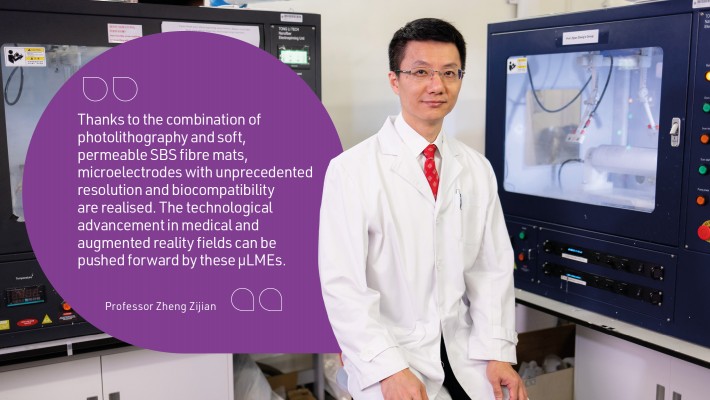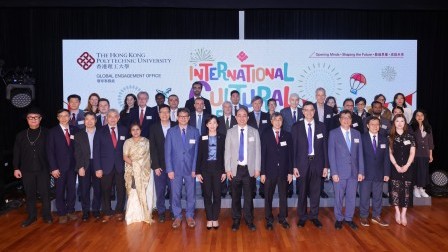Groundbreaking invention for implantable bioelectronic devices: Liquid Metal Microelectrodes with soft, stretchable and permeable properties
Professor Zheng Zijian
Chair Professor of Soft Materials and Devices, Department of Applied Biology and Chemical Technology
Lead Investigator, Otto Poon Charitable Foundation Research Institute for Smart Energy
Associate Director, Research Institute for Intelligent Wearable Systems
Associate Director, University Research Facility in Materials Characterization and Device Fabrication
PolyU-led Interdisciplinary Research Team, led by Professor Zheng Zijian, Chair Professor of Soft Materials and Devices in the Department of Applied Biology and Chemical Technology, has successfully developed a new type of liquid metal microelectrodes (μLMEs) with unprecedented flexibility, stretchability, and permeability, which can be applied in implantable biocompatible electronic devices. The research findings have been published in the international scientific journal Science Advances.
Achieving long-term biocompatibility
The team placed a fibrous polymer onto silver (Ag) micropatterns using electrospinning to create μLMEs, enabling patterning at an ultra-high density of up to 75,500 electrodes per square centimetre, surpassing the previous achievements by thousands of times. These cutting-edge μLMEs possess long-term biocompatibility, allowing comfortable wear on human skin, and have been demonstrated for specific applications in monitoring animal brains.
Previous biocompatible electronic devices were fabricated on porous elastomers, but the porosity and roughness of these substrates limited the patterning resolution, making it challenging to increase electrode density. The research team successfully overcame this bottleneck by using the technique of photolithography to place electronic circuitry onto the fibrous polymer substrates, achieving a thin and flexible structure that is highly conductive under high strain and possesses long-term biocompatibility, similar to thin paper.
The conductive component used in μLMEs, eutectic gallium-indium (EGaIn), is a liquid metal alloy with a low melting temperature that maintains conductivity under extreme strain. It is also flexible and highly biocompatible. During the fabrication process, the circuitry patterns made of EGaIn is placed onto a permeable "fibre mat" created through electrospinning. This fabrication method results in a soft, flexible and stretchable electronic device suitable for comfortable wear and implantation. The concept of a super-elastic fibre mat was first developed by Professor Zheng’s team in 2021 and is now adopted in the newly developed μLMEs.

μLMEs with a high density of 75,500 electrodes/cm2
To validate the flexibility and stretchability of μLMEs for use as an ideal choice for implantable neural interfaces for brain monitoring, the team synthesised a μLMEs array with small electrode diameter and high channel density to serve as an electrocorticography signal receiver in the rat brain. The μLMEs exhibits mechanical properties similar to brain tissues, allowing it to attach closely to the cortical surface and accurately record neural signals in vivo. When a sleeping rat generates identifiable brainwaves during non-rapid eye movement sleep, the μLMEs array can precisely detect somatosensory evoked potentials resulting from electrical stimulation applied to different parts of the body.
Unlocking new possibilities in implantable bioelectronics
Notably, the softness and stretchability of the μLMEs also make them ideal for implantation at the neural interface for brain monitoring. The exceptional properties of the μLMEs also extend their applications beyond brain monitoring. When applied to human skin, these μLMEs electronic patches leave only trace or even no residues when subjected to pressure, making them highly promising in the field of wearable electronics. Their potential applications range from physiological monitoring to medical diagnosis and interactive technology.
The research team, supported by funding from the Research Grants Council’s Senior Research Fellow Scheme, PolyU, City University of Hong Kong, the National Natural Science Foundation of China, and InnoHK, remains committed to pushing boundaries further, aiming to enhance the patterning resolution of μLMEs, and unlock new possibilities in the field of implantable bioelectronics.






